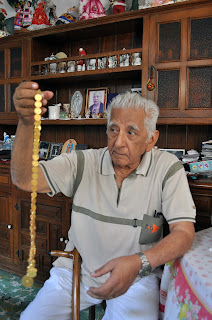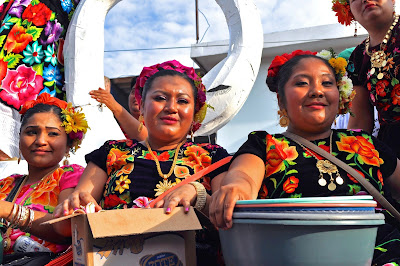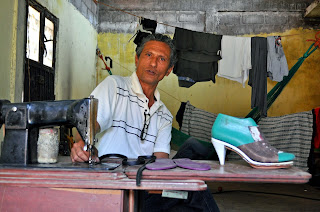I have walked in
front of La Esmeralda Relojería numerous times in the past two years on my way
to la Casa de la Cultura in Juchitán. It always caught my attention, reminding
me of a storefront in Habana or el Puerto de Vera Cruz. The pull down metal
door was wide open exposing the glass counters filled with jewelry, clocks and
watches.
There was always someone sitting in the entryway, often an
older, gray-haired man visiting with friends. I wanted very
much to ask if I could take a photograph, but I was too shy, too afraid of
being refused. But this time I decide, “why not, they can only say no”. But
they didn’t!
I greeted the
gray-haired man sitting in the entryway and approached the man working on a
watch at the counter. I told him that I was working on a
book project about “oficios” and showed him the 5x7 booklet I always carry with
me of photos I have already taken of people doing their job. He recognized a
few of the Juchitecos in the booklet and said it was fine to photograph him
working, but asked me to make sure to take a few shots of his father, Vicente, the gray-haired
man in the entryway. I agreed and told him I would bring him the photos a bit
later.
And so the story
began. I arranged to come back later to shoot and to do an interview with
him. When I returned, José showed me into the living area behind
the workshop and told me he would get his father. It was then that I realized
that this interview would not be with José, but his father Vicente. La
Esmeralda was his creation.
Don Vicente Fuentes Pineda is
eighty-nine years old and has recently retired from his profession as jeweler
and clockmaker due to failing eyes and trembling hands. But his mind is steady
and sharp, even if his hands and eyes are not. He had no trouble looking back over the past eight and a half
decades of his life.
As so many of the
people I have interviewed, Vicente finished primary school and took up the trade of jeweler. He worked with his brother-in-law in a shop that made gold jewelry and
sold precision Swiss clocks. After a time, Vicente decided he wanted to learn
how to assemble and repair the clocks they sold. So he left his wife and two
children and moved to Mexico City for a year where he found a relojero (clockmaker) who agreed to take
him on as an apprentice and teach him the fine art of assembling and repairing Swiss
clocks. When he finished his apprenticeship, he returned to his family in
Juchitán and continued working with his brother-in-law in La Esmeralda.
 I had gone to a vela (popular festival) in San Blas, an indigenous pueblo
close to Juchitán, with a Mexican photographer friend who had invited me to
accompany him in 1998. I was very impressed by the Juchiteca women that were
decked out in amazing displays of gold jewelry. Even some of their teeth had gold caps! I found that it was not gold plated jewelry they were wearing, but
pure gold. I was told it was a way of showing your social status in el Istmo.
I had gone to a vela (popular festival) in San Blas, an indigenous pueblo
close to Juchitán, with a Mexican photographer friend who had invited me to
accompany him in 1998. I was very impressed by the Juchiteca women that were
decked out in amazing displays of gold jewelry. Even some of their teeth had gold caps! I found that it was not gold plated jewelry they were wearing, but
pure gold. I was told it was a way of showing your social status in el Istmo.
Vicente was one of
the jewelers who made those pure gold necklaces, bracelets, and earrings. He
told me that when he was younger, gold was much cheaper. What then cost
ten pesos now costs four hundred. He used to make chains and bracelets of pure
gold coins that weighed 100 grams (3.5 oz). Besides showing social status,
Vicente said it was more importantly a way of having capital to pay for the
harvest when the rains came. Juchitán and the surrounding pueblos have a gold-
based economy. The gold is pawned to cover the costs of the harvest, and when
it is over, the woman buy back their gold jewelry. The same process goes on to
this day.
Unfortunately,
times have changed. Organized crime has moved into the Juchitán area and it is
no longer safe to wear the gold jewelry in public. Instead it is stored in safe
deposit boxes and brought out only when it is exchanged for cash for the
harvest.
 When it was close
to my departure, Vicente sent his grandson, Diego, out to find me at la Casa de
la Cultura. As a thank you for the photos I gave him, he sent me a stack of
fresh totopos (traditional corn tostadas from Juchitán) and a piece of queso seco (Parmesan type cheese) for the trip
back home. He is a man with heart of gold!
When it was close
to my departure, Vicente sent his grandson, Diego, out to find me at la Casa de
la Cultura. As a thank you for the photos I gave him, he sent me a stack of
fresh totopos (traditional corn tostadas from Juchitán) and a piece of queso seco (Parmesan type cheese) for the trip
back home. He is a man with heart of gold!
Vicente lost three
of his sisters during the past year. All were over eighty. As he approaches ninety,
he is still very alert and full of life. But he knows the clock is ticking. Luckily,
he is a master clockmaker and knows very well how to deal with time. He could
be with us for a long spell yet. I hope so.












